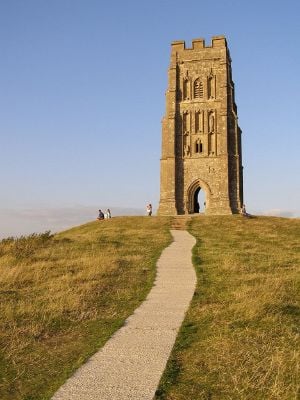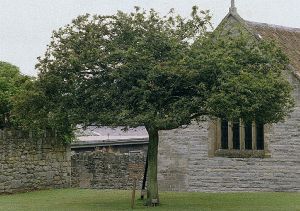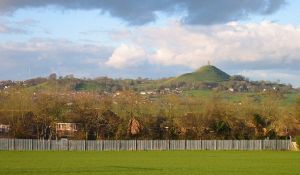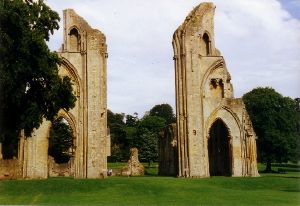Difference between revisions of "Glastonbury" - New World Encyclopedia
m (Rename to Geography) |
Mary Anglin (talk | contribs) |
||
| Line 1: | Line 1: | ||
| − | {{claimed}} | + | {{claimed}}{{help}} |
{{infobox UK place| | {{infobox UK place| | ||
Revision as of 19:47, 29 October 2007
| Glastonbury | |
|
Glastonbury shown within Somerset | |
| Population | 8,800 |
|---|---|
| OS grid reference | |
| District | Mendip |
| Shire county | Somerset |
| Region | South West |
| Constituent country | England |
| Sovereign state | United Kingdom |
| Post town | GLASTONBURY |
| Postcode district | BA6 |
| Dialling code | 01458 |
| Police | Avon and Somerset |
| Fire | Devon and Somerset |
| Ambulance | South Western |
| European Parliament | South West England |
| UK Parliament | Wells |
| List of places: UK • England • Somerset | |
Glastonbury is a small town in Somerset, England, situated at a dry point on the Somerset Levels, 50km (31 miles) south of Bristol. The town has a population of 8,800 (2002 estimate). It is in the Mendip district.
The town is known for its history, including Glastonbury Abbey and Glastonbury Tor, the many myths and legends associated with the town, and the Glastonbury Festival which takes place in the nearby village of Pilton.
On 5 May 2003, Glastonbury was granted Fairtrade Town status.
History and mythology
The town is particularly notable for the myths and legends surrounding a nearby hill, Glastonbury Tor, which rises up from the otherwise flat landscape of the Somerset Levels. These myths concern Joseph of Arimathea and the Holy Grail, and also King Arthur. Glastonbury is also said to be the centre of several ley lines.
The Joseph of Arimathea legend relates to the idea that Glastonbury was the birthplace of Christianity in the British Isles, and that the first British church was built there at Joseph's behest to house the Holy Grail, 30 or so years after the death of Jesus. The legend also says that earlier Joseph had visited Glastonbury along with Jesus as a Child. The legend probably has its origins in the mediaeval period when religious relics and pilgrimages were profitable business for abbeys. However William Blake believed in this legend and wrote the poem that became the words to the most patriotic of English songs, 'Jerusalem' (see And did those feet in ancient time).
Joseph is said to have arrived in Glastonbury by boat over the flooded Somerset Levels. On disembarking he stuck his staff into the ground, which flowered miraculously into the Glastonbury Thorn (or Holy Thorn). This is the explanation behind the existence of a hybrid hawthorn tree that only grows within a few miles of Glastonbury. This hawthorn flowers twice annually, once in spring and again around Christmas time (depending on the weather). Each year a sprig of thorn is cut by the local Church of England priest and the eldest child from St Johns school then sent to the Queen to feature on her Christmas table top.
The original Holy Thorn was a centre of pilgrimage in the Middle Ages but was chopped down during the English Civil War (in legend the roundhead soldier who did it was blinded by a flying splinter). A replacement thorn was planted in the 20th century on Wearyall hill (originally in 1951 to mark the Festival of Britain; but the thorn had to be replanted the following year as the first attempt did not take); but many other examples of the thorn grow throughout Glastonbury including those in the grounds of Glastonbury Abbey, St Johns Church and Chalice Well.
In some versions of the Arthurian myth, Glastonbury is conceived of as the legendary island of Avalon. An early Welsh story links Arthur to the Tor in an account of a face-off between Arthur and the Celtic king, Melwas, who had apparently kidnapped Arthur's wife Queen Guinevere. Geoffrey of Monmouth first identified Glastonbury with Avalon in 1133. In 1191, monks at the Abbey claimed to have found the graves of Arthur and Guinevere to the south of the Lady Chapel of the Abbey church, which was visited by a number of contemporary historians including Giraldus Cambrensis. The remains were later moved, and lost during the Reformation. Many scholars suspect that this discovery was a pious forgery to substantiate the antiquity of Glastonbury's foundation, and increase its renown.
Also, according to some versions of the Arthurian legend, it was Glastonbury Abbey to which Lancelot retreated in penance following the death of Arthur.
The town today
Glastonbury today is a centre for religious tourism and pilgrimage. Diverse strains of mysticism and paganism co-exist with the followers of its Christian heritage. As with many towns of similar size, the centre is not as thriving as it once was but Glastonbury supports a remarkable number of alternative shops. The outskirts of the town include a DIY shop and the slow redevelopment of a former sheepskin and slipper factory site, once owned by Morlands. Although the redevelopment has been slow, clearance of the site has begun with a dramatic change to its appearance.
Glastonbury received national media coverage when, in 1999, cannabis plants were found in the town's floral displays.
The ruins of the abbey are open to visitors; the abbey had a violent end during the Dissolution and the buildings were progressively destroyed as their stones were removed for use in local building work. The remains of the Abbot's Kitchen (a grade I listed building.[1]) and the Lady Chapel are particularly well-preserved. Not far away is situated the Somerset Rural Life Museum, which includes the restored Abbey Barn.[2] Other points of interest include St. John's Church, the Chalice Well, and the historic George and Pilgrims Inn,[3] built to accommodate visitors to the Abbey.
The walk up the Tor to the distinctive tower at the summit (the partially restored remains of an old church) is rewarded by vistas of the Mid-Somerset area including the Levels, drained marshland. From there, 150m above sea level, it is easy to appreciate how Glastonbury was once an island and, in the winter, the surrounding moors are often flooded, giving that appearance once more.
The local football side is Glastonbury F.C.
Local people
- The writer Matthew Squire was born in Glastonbury.
- King Arthur and Guinevere were supposedly buried at Glastonbury Abbey
- Gary Stringer, lead singer of Reef, attended St Dunstan's school in Glastonbury for a brief period.
- The occultist and writer Dion Fortune lived and is buried in Glastonbury.
- The writer and historian Geoffrey Ashe, known for his works on local legends, lives in Glastonbury, in the house that had once belonged to Dion Fortune.
- The juggler Haggis McLeod and his wife Arabella Churchill
Transport
The Glastonbury Canal ran just over 14 miles through two locks from Glastonbury to Highbridge where it entered the Bristol Channel in the early 1800s, however this became uneconomic with the arrival of the railway.
Glastonbury and Street was the biggest station on the original Somerset and Dorset Joint Railway main line from Highbridge to Evercreech Junction until closed in 1966 under the Beeching axe. It was the junction for the short branch line to Wells which closed in 1951.
ReferencesISBN links support NWE through referral fees
- ↑ Abbot's Kitchen, Glastonbury Abbey. Images of England. Retrieved 2006-11-11.
- ↑ Abbey Tithe Barn. Images of England. Retrieved 2006-11-11.
- ↑ George Hotel and Pilgrims' Inn. Images of England. Retrieved 2006-11-11.
- Geoffrey Ashe, King Arthur's Avalon: The Story of Glastonbury, 1957
See also
- Glastonbury Tor
- Glastonbury Abbey
- A Glastonbury Romance by John Cowper Powys
- King Arthur
External links
- Official town council and community website
- The Glastonbury search engine
- Isle of Avalon
- Library of Avalon (specialist esoterica)
- Glastonbury Pilgrimage Association, Annual Christian pilgrimage led by local churches
- Glastonbury Pilgrim Reception Centre Support and advice for pilgrims researching their visit to Glastonbury
- Glastonbury, The Somerset Urban Archaeological Survey by Clare Gathercole
- Benedictine Abbey of Glastonbury A History of the County of Somerset: Vol 2: (1911)
- Photos of Glastonbury in 3d (Anaglyphs)
Credits
New World Encyclopedia writers and editors rewrote and completed the Wikipedia article in accordance with New World Encyclopedia standards. This article abides by terms of the Creative Commons CC-by-sa 3.0 License (CC-by-sa), which may be used and disseminated with proper attribution. Credit is due under the terms of this license that can reference both the New World Encyclopedia contributors and the selfless volunteer contributors of the Wikimedia Foundation. To cite this article click here for a list of acceptable citing formats.The history of earlier contributions by wikipedians is accessible to researchers here:
The history of this article since it was imported to New World Encyclopedia:
Note: Some restrictions may apply to use of individual images which are separately licensed.



